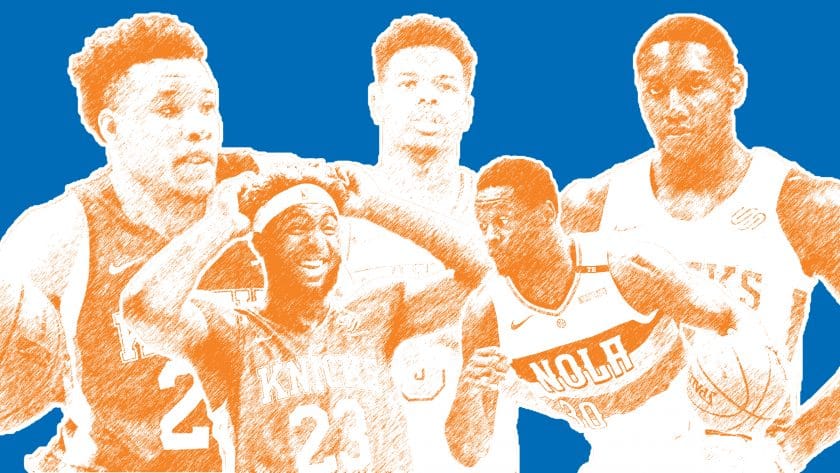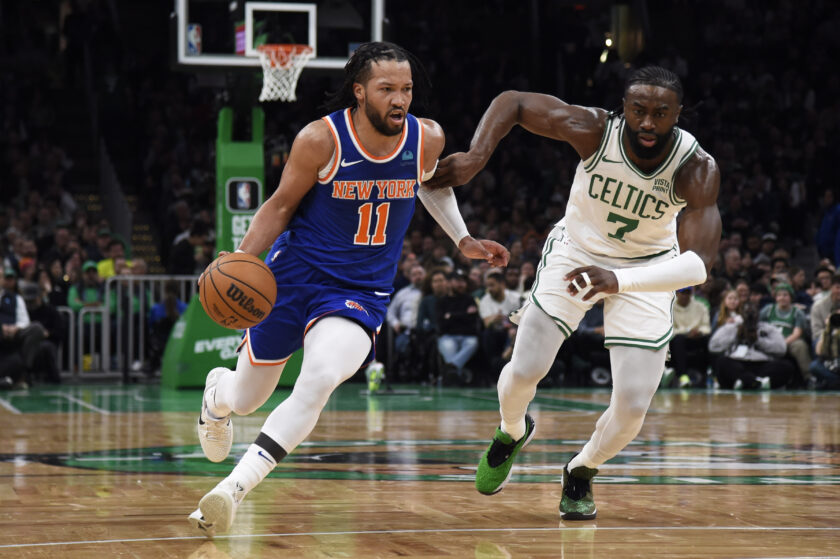New York Knicks film room: Transition offense is key for this young group

The young core of the New York Knicks has a lot to offer in the transition game and each player brings a unique wrinkle to the offense.
[sc name=”Small Film Room”]The New York Knicks have to develop an identity in year two with David Fizdale at the helm. It’s fair to give him a pass in year one. The Knicks were a young team that underwent major changes during the season, but year two comes with greater expectations.
The 90s Knicks were rough-and-tumble teams who showed up for a fistfight as much as a basketball game. The Showtime Lakers were the most entertaining thing on a basketball court. Who are the 2019-20 Knicks?
Hopefully, they’re more Showtime than 90s Knicks. Opening up the transition game could kickstart the development of the young core. Despite the rash of veteran signings, the Knicks should be focusing their effort into developing the players who are going to be on the roster past the next two seasons.
Dennis Smith Jr., RJ Barrett, Kevin Knox, Julius Randle, and Mitchell Robinson are young, talented players who should be in the team’s long-term plans. Don’t expect to see this group start opening night against the San Antonio Spurs, but this unit should see significant time on the court together next season.
Better yet, each player can bring a unique ingredient to the transition offense for the Knicks. Admittedly, we’re taking a rose-colored view of each player here and ignoring their weaknesses, but it’s summertime. There will be plenty of time to criticize the Knicks in the future. For now, let’s focus on a few positives.
[sc name=”Knicks Title” text=”PG — Dennis Smith Jr. — Athleticism” ]It takes a few years for point guards to learn how to play the position in the NBA. As a rule, we should reserve judgment on any young point guard until he’s had a few years to develop. Smith is no exception to that rule. He still has a long way to go before he can be considered the future at the position for the Knicks.
Smith has undeniable athleticism. The highlight dunks are cool, but it’s about much more than that. Fizdale wants his guards to end up with two feet in the paint every time down on the break. Once he’s there, Smith has the natural ability to finish through contact or throw a ridiculous alley-oop to a big man knifing through the lane.
The transition game hasn’t been Smith’s strong suit in his career. He scored 1.04 points per possession (PPP) in transition as a rookie. That number dipped to below 0.9 during his second season. With all that said, Smith’s transition efficiency should improve as he develops chemistry with his new teammates.
[sc name=”Knicks Title” text=”SG — RJ Barrett — Finishing At The Rim” ]Barrett is far from a finished product. Like any rookie, the 19-year-old has a laundry list of things to improve upon. We can live with the growing pains as long as he’s showing overall growth. He’s going to make mistakes and probably won’t shoot for a high percentage.
But Barrett is entering the league with a reputation as a scorer. Let’s see the Knicks run and gun with the hopes of opening up lanes for a slashing Barrett. He’s a lefty, which adds an interesting wrinkle to the Knicks, but he showed a willingness to finish with either hand in the Las Vegas Summer League.
[sc name=”Knicks Center”] [sc name=”Knicks Title” text=”SF — Kevin Knox — Spot Up Shooting” ]Yes, Knox can and should be more than a spot-up three-point shooter. But if he’s going to reach his full potential, Knox needs to become a knockdown catch-and-shoot threat. The 20-year-old shot 34% on catch-and-shoot threes last season.
There are few better catch-and-shoot opportunities than in transition. The best shooters in the league always seem to find the open space on the perimeter. In the second clip in the video below, there’s a specific moment where Knox exhibits this “shooter’s sixth sense,” for lack of a better term.
After the 76ers contain Knox’s drive, he gives up the ball to Luke Kornet on the perimeter. Rather than relaxing after the pass, Knox takes a quick peek at Ben Simmons and spots up for the top-of-the-key three. Look for more of that next season.
[sc name=”Knicks Title” text=”PF — Julius Randle — Grab-And-Go” ]Randle is a unique talent. He’s not your father’s power forward, but he’s not quite the stretch-four type that’s en vogue in today’s game. Despite his reputation as a bruiser, Randle can handle the rock.
There’s no need for an outlet pass when Randle is grabbing the ball out of the air. Anytime the guards see Randle corral a rebound or snatch a steal, they should be off to the races.
Once he gets two feet in the paint—again, something Fizdale preaches—it’s almost over for the defense. He has the strength to finish amid a sea of defenders or the vision to find the open cutter.
Sidenote: When the Knicks don’t have a look right away, they’ll often go into deep pick-and-rolls by the elbow. That means we may see Randle and Robinson running big-to-big pick-and-rolls next season.
[sc name=”Knicks Title” text=”C — Mitchell Robinson — Controlled Blocks” ]Robinson’s overall shot-blocking ability is elite. After all, he averaged 2.4 blocks per game as a rookie. The old adage goes: Defense leads to offense. As far as the transition game is concerned, Robinson can kickstart fast breaks by controlling where his blocks go.
For such a young player, Robinson is adept at keeping the ball inbounds when he blocks a shot. Sending a shot five rows deep in Madison Square Garden looks great on a highlight, but blocking a shot that leads to an easy bucket is every coach’s dream.
And oh yeah, Robinson’s blocks often end with highlight-reel slams on the other end. The Louisiana native has the chance to be a special player on both ends of the court.
[sc name=”Knicks Link Next” link=”https://elitesportsny.com/2019/08/08/new-york-knicks-film-room-frank-ntilikina-fits-the-french-system/” text=”Frank Ntilikina Fits The French System (Film Room)” ]




